Kirkby-in-Ashfield
By MR. G. G. BONSER.
THE Church of Kirkby-in-Ashfield stands on the edge of an escarpment overlooking the infant waters of the Erewash, and on a well chosen site at the head of the vale, where it may be seen from practically the whole of the extensive parish of 5,590 acres.
Its history remains to be written, though Thoroton gives a long and interesting account of the Fitzhuberts, the Stutevilles, the Darcys, the De Insulas, the Pierpoints, and the Langtons, all of whom held manors and houses in the parish; but, rather curiously, nothing is said of the house of Kirkby Hardwick, except as having been the residence of Sir Henry Pierpoint, though it is generally understood to have been a Sub-Priory of Newstead, and is certainly the house where Cardinal Wolsey was seized with his last illness.
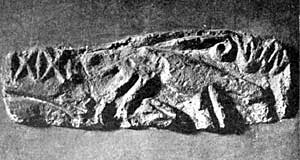
Carved stone (Plate I).
Thoroton, too, says nothing about the church, not even that Radulphus D’Eyncourt, who founded. Thurgarton Priory, A.D. 1130, presented Kirkby Church to it, nor does he mention any connection of this most remarkable family with the parish. We are told, however, that in Domesday Book “there was a Church and a Priest, and two Mills.” Of this church nothing whatever. remains. Perhaps the stone of which we give an illustration (Plate I.), and which was preserved on the north wall of the tower; a fine foliated cross on a sepulchral slab 5ft. long, with a sword on the sinister side, 3iins. long, and the heads of three other crosses, the former being found under the Early English work, are all that is left of the Norman period, and of the Fitzhuberts and D’Eyncourts.
It will be seen from the excellent ground plan, kindly supplied by the present architect, Louis Ambler, Esq., that about 1150 A.D. there was a church with a nave, and also an aisle, divided from it by a richly moulded arcade of three semicircular arches and round columns with carved caps, as may be seen by Grimm’s drawing, circa 1780.
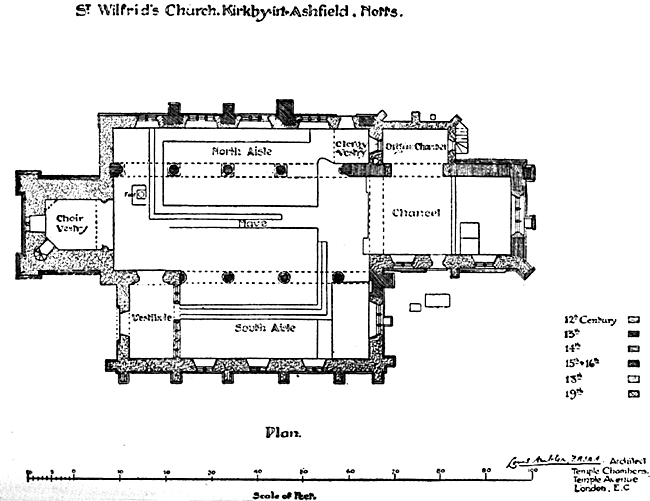
Whether the Fitzralphs or the Stutevilles, who were either joint owners or held separate manors in A.D. 1187, or D’Eyncourt built this portion, future historians may decide.
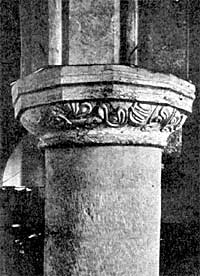
Plate II. North-east pillar.
However, towards the end of the 12th century, the arcade was extended eastwards by the addition of an arch of wider span but similarly moulded, and two half columns, one built against the easternmost half column of the existing arcade, and the other forming part of a new pier. On the cap of the former there was a very curious and interesting carving of a mermaid, a drawing of which, by Grimm, is here presented, together with a photo taken a few years ago. (Plate II.)
 |
| Carving on east side of cap to above pillar. |
In the 13th century, the chancel and the tower were built, the archway to the latter being richly moulded. The chancel was probably the same width as the nave, and it is doubtful whether there was an arch between them, the existing arch being certainly of a later date.
Probably there was an aisle on the south side at this period, as the caps of the octagonal columns of the 14th century arcade seem to have belonged to an earlier colonnade, and to have been reused. The proportions of the arches point to the 14th century, and the doorway on the south side of the chancel seems to have belonged to the same period, though it had been rebuilt.
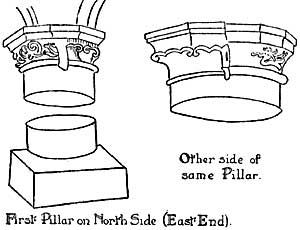 |
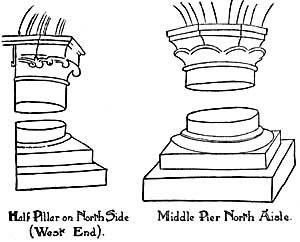 |
A curious feature of the above arcade was a narrow arch at the east end owing to the placing of the columns opposite those of the 12th century on the north side, and as will be seen from the view of the interior, the small arch had its respond on the chancel wall, whereas the north arcade had some feet of walling between its respond and the chancel wall.
The Lords Darcy held the manor for upwards of a century—1341 to 1454—it being granted to them by King Edward III. on its forfeiture by the Stutevilles, and be enclosed a park there. The family of De Insula also held a manor at Kirkby Woodhouse early in the 14th century, one of them, Roger, being Keeper of the King’s Great Wardrobe, Reginald and Nicholas being large benefactors to the Canons of Felley, while Robert le Gaunt, who succeeded Robert de Insula, left land to Felley and, inter alia, 6d. to the Light of the blessed Mary the Virgin in the Church of Kirkby. This south aisle may have been built by them.
The mouldings of the south arcade are very plain, but the masks at the angles on the caps relieve its uninteresting appearance.
